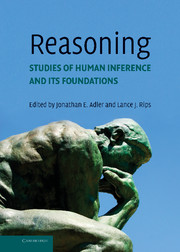Book contents
- Frontmatter
- Contents
- Preface
- List of Contributors
- Introduction: Philosophical Foundations
- PART I FOUNDATIONS OF REASONING
- PART II MODES OF REASONING
- PART II INTERACTIONS OF REASONING IN HUMAN THOUGHT
- Section 9 Reasoning and Pragmatics
- Section 10 Domain-Specific, Goal-Based, and Evolutionary Approaches
- 39 Domain-Specific Knowledge and Conceptual Change
- 40 Pragmatic Reasoning Schemas
- 41 Beyond Intuition and Instinct Blindness: Toward an Evolutionarily Rigorous Cognitive Science
- 42 Use or Misuse of the Selection Task? Rejoinder to Fiddick, Cosmides, and Tooby
- 43 Why We Are So Good at Catching Cheaters
- 44 The Modularity of Mind: An Essay on Faculty Psychology
- 45 Commitment
- 46 Evolution of Inference
- Section 11 Reasoning and Cultures
- Section 12 Biology, Emotions, and Reasoning
- Index
- References
44 - The Modularity of Mind: An Essay on Faculty Psychology
Published online by Cambridge University Press: 05 June 2012
- Frontmatter
- Contents
- Preface
- List of Contributors
- Introduction: Philosophical Foundations
- PART I FOUNDATIONS OF REASONING
- PART II MODES OF REASONING
- PART II INTERACTIONS OF REASONING IN HUMAN THOUGHT
- Section 9 Reasoning and Pragmatics
- Section 10 Domain-Specific, Goal-Based, and Evolutionary Approaches
- 39 Domain-Specific Knowledge and Conceptual Change
- 40 Pragmatic Reasoning Schemas
- 41 Beyond Intuition and Instinct Blindness: Toward an Evolutionarily Rigorous Cognitive Science
- 42 Use or Misuse of the Selection Task? Rejoinder to Fiddick, Cosmides, and Tooby
- 43 Why We Are So Good at Catching Cheaters
- 44 The Modularity of Mind: An Essay on Faculty Psychology
- 45 Commitment
- 46 Evolution of Inference
- Section 11 Reasoning and Cultures
- Section 12 Biology, Emotions, and Reasoning
- Index
- References
Summary
A Functional Taxonomy of Cognitive Mechanisms
I want to argue that the current best candidates for treatment as modular cognitive systems share a certain functional role in the mental life of organisms; the discussion in this section is largely devoted to saying which functional role that is. As often happens in playing cognitive science, it is helpful to characterize the functions of psychological systems by analogy to the organization of idealized computing machines. So, I commence with a brief digression in the direction of computers.
When philosophers of mind think about computers, it is often Turing machines that they are thinking about. And this is understandable. If there is an interesting analogy between minds qua minds and computers qua computers, it ought to be possible to couch it as an analogy between minds and Turing machines, since a Turing machine is, in a certain sense, as general as any kind of computer can be. More precisely: if, as many of us now suppose, minds are essentially symbol-manipulating devices, it ought to be useful to think of minds on the Turing-machine model since Turing machines are (again “in a certain sense”) as general as any symbol-manipulating device can be.
However, as we have already had reason to observe, Turing machines are also very simple devices; their functional architecture is exhaustively surveyed when we have mentioned a small number of interacting subsystems (tape, scanner, printer, and executive) and a small inventory of primitive machine operations (stop, start, move the tape, read the tape, change state, print).
- Type
- Chapter
- Information
- ReasoningStudies of Human Inference and its Foundations, pp. 878 - 914Publisher: Cambridge University PressPrint publication year: 2008
References
- 8
- Cited by



